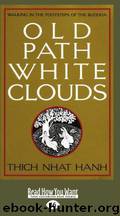Old Path White Clouds: Walking in the Footsteps of the Buddha by Thich Nhat Hanh

Author:Thich Nhat Hanh
Language: eng
Format: mobi, epub
Tags: General, Religion, Buddhism, Biography & Autobiography, Religious, History
ISBN: 9781458768254
Publisher: ReadHowYouWant.com
Published: 2010-03-18T02:11:12+00:00
Chapter Forty-Eight
Covering Mud with Straw
Venerable Moggallana suggested a meeting take place between the Buddha’s senior disciples at Jetavana and the principal instigators of the Kosambi conflict. The goal of the meeting was to learn from the experience in order to come up with ways to prevent such conflicts from taking place again. Venerable Mahakassapa presided over the meeting.
To begin the meeting, Mahakassapa asked Anuruddha to repeat the six principles of harmonious living that the Buddha had expounded during his stay at Eastern Bamboo Forest. After hearing Anuruddha explain the six principles, Moggallana suggested that bhikkhus and bhikkhunis in all monastic centers be asked to memorize them.
After four days of discussion, the bhikkhus in the meeting formulated seven practices of reconciliation to be used to settle disputes within the sangha. They named these seven methods Saptadhikarana-samatha:
The first practice is sammukha-vinaya, or Face-to-Face Sitting. According to this practice, the dispute must be stated before the entire convocation of bhikkhus, with both sides of the conflict present. This is to avoid private conversations about the conflict which inevitably influence people against one side or the other, creating further discord and tension.
The second practice is smrti-vinaya, or Remembrance. In the convocation, both parties involved try to remember from the beginning everything that led up to the conflict. Details should be presented with as much clarity as possible. Witnesses and evidence should be provided, if available. The community listens quietly and patiently to both sides in order to obtain adequate information to examine the dispute.
The third practice is amudha-vinaya, or Non-stubbornness. The monks in question are expected to resolve the conflict. The community expects both parties to demonstrate their willingness to reach reconciliation. Stubbornness is to be considered negative and counterproductive. In case a party claims he violated a precept because of ignorance or an unsettled state of mind, without actually intending to violate it, the community should take that into account in order to find a solution that is agreeable to both sides.
The fourth practice is tatsvabhaisya-vinaya, or Voluntary Confession. Each party is encouraged to admit his own transgressions and shortcomings without having to be prodded by the other party or the community. The community should allow each party ample time to confess his own failings, no matter how minor they may seem. Admitting one’s own faults begins a process of reconciliation and encourages the other party to do likewise. This leads to the possibility of full reconciliation.
The fifth practice is pratijñakaraka-vinaya, or Accepting the Verdict. When the verdict is reached, jñapticaturthinkarmavacana, it will be read aloud three times. If no one in the community voices disagreement with it, it is considered final. Neither party in dispute has the right to challenge the verdict. They have agreed to place their trust in the community’s decision and carry out whatever verdict the community reaches.
The sixth practice is yadbhuyasikiya-vinaya, or Decision by Consensus. After hearing both sides and being assured of the wholehearted efforts by both sides to reach a settlement, the community reaches a verdict by consensus.
Download
Old Path White Clouds: Walking in the Footsteps of the Buddha by Thich Nhat Hanh.epub
This site does not store any files on its server. We only index and link to content provided by other sites. Please contact the content providers to delete copyright contents if any and email us, we'll remove relevant links or contents immediately.
The Way of Zen by Alan W. Watts(6513)
Ego Is the Enemy by Ryan Holiday(5298)
The Art of Happiness by The Dalai Lama(4065)
The Book of Joy by Dalai Lama(3904)
Why Buddhism is True by Robert Wright(3406)
Spark Joy by Marie Kondo(3253)
Shift into Freedom by Loch Kelly(3140)
Happiness by Matthieu Ricard(2996)
A Monk's Guide to a Clean House and Mind by Shoukei Matsumoto(2870)
The Lost Art of Good Conversation by Sakyong Mipham(2580)
The Meaning of the Library by unknow(2508)
The Unfettered Mind: Writings from a Zen Master to a Master Swordsman by Takuan Soho(2250)
The Third Eye by T. Lobsang Rampa(2227)
Anthology by T J(2166)
Red Shambhala by Andrei Znamenski(2154)
The Diamond Cutter by Geshe Michael Roach(2023)
Thoughts Without A Thinker: Psychotherapy from a Buddhist Perspective by Epstein Mark(1966)
Twilight of Idols and Anti-Christ by Friedrich Nietzsche(1854)
Advice Not Given by Mark Epstein(1840)
